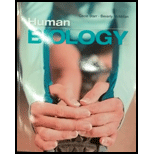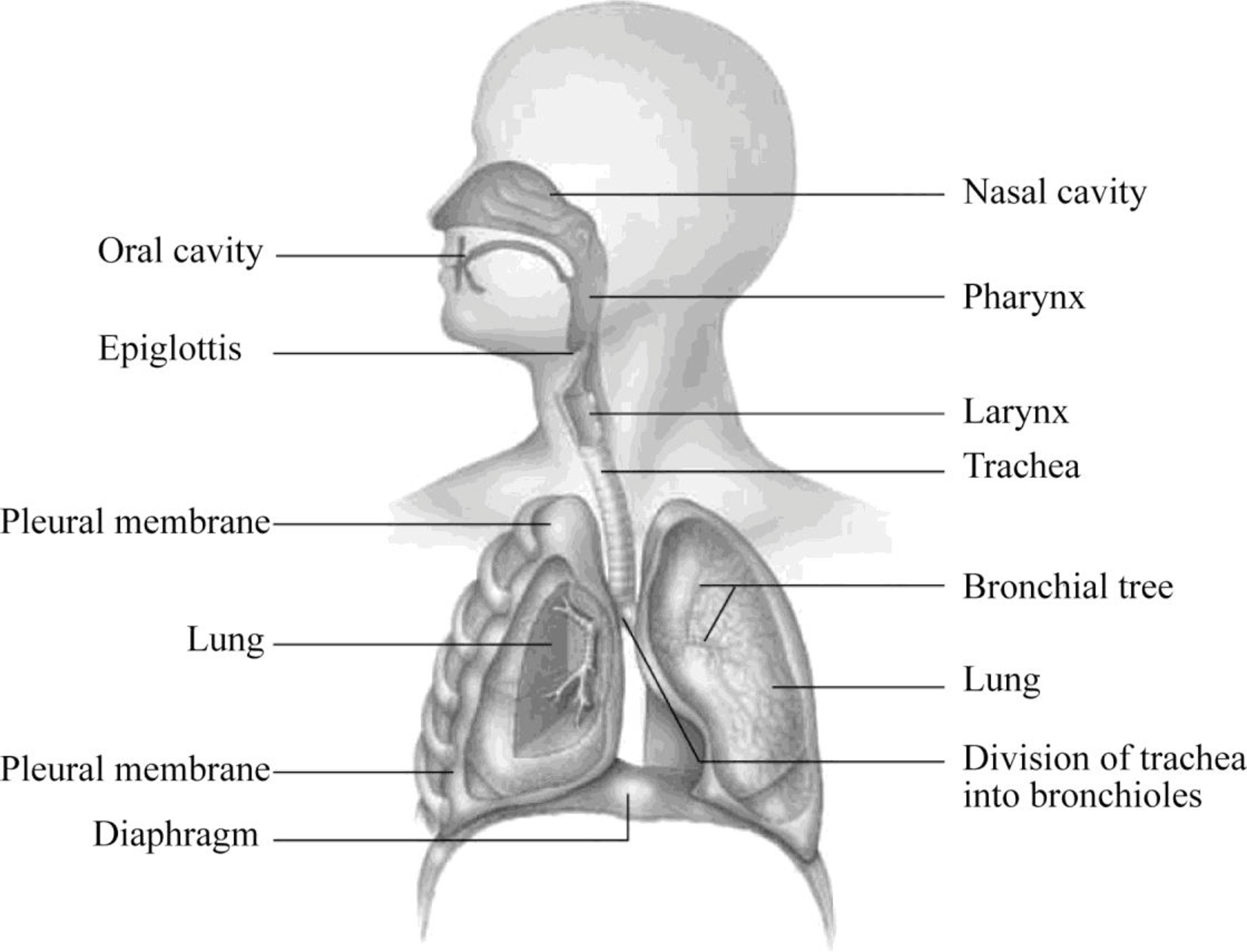
In the diagram below, label the parts of the respiratory system and the structures that enclose some of its parts

To label: The parts of the respiratory system and the structure that surrounds the parts of respiratory system.
Introduction: The process of gas exchange that occurs between an organism and its environment is known as respiration. For cellular respiration, most of the animal cells need a continuous oxygen supply. During respiration, oxygen is inhaled from the environment and transported to individual cells of the body. Carbon dioxide produced during the cellular respiration is exhaled from the body to the environment.
Answer to Problem 1RQ
Pictorial representation: Fig.1 shows the parts of the respiratory system and the structure that encloses some of its parts.

Fig.1: Parts of the respiratory system and the structure that encloses some of its parts
Explanation of Solution
Oral cavity: It is the additional airway when breathing through nasal cavity is ceased.
Nasal cavity: The nasal cavity is oblong-shaped and extends from the nostril to the posterior nasal apertures. The posterior nasal apertures lead into the pharynx.
Pharynx: Pharynx is commonly known as the throat. It is a funnel-shaped pathway of about 13 centimeters in length. It is the common passageway for food and air.
Epiglottis: A flap like structure present in the throat which keeps the food from entering the windpipe and the lungs is called epiglottis.
Larynx: Larynx is also known as the voice box. It is a cylindrical structure of about 4 centimeters in length. It is continuous inferiorly with trachea and superiorly with laryngopharynx.
Trachea: The trachea is a slightly rigid, flexible, and tubular organ that referred to as windpipe. It is an open tube that attaches to the larynx and to two main bronchi.
Pleural membrane: It is double layered membrane that fills with fluid. It keeps the lungs airtight and mostly helps them to stick to the chest wall during breathing.
Bronchial tree: The highly branched system of the respiratory pathway is known as bronchial tree. The bronchial tree originates at the main bronchi and gradually branches into the narrower tubes of the respiratory pathway.
Lungs: Lungs are an important part of the respiratory system. It is the lobed elastic organ that processes the exchange of gaseous which consists of the delivery of oxygen from the lungs to the blood stream and the elimination of carbon dioxide from the blood stream to the lungs.
Diaphragm: It is the muscular sheet present between the plural cavity and abdominal cavity. It has an important role in breathing process, in inhalation it contracts and flattens and in exhale, it relaxes.
Division of trachea into bronchioles: Bronchioles represent the ending portion of the conducting pathway of the respiratory system. These bronchioles lead into the initial segments of the respiratory zone (respiratory bronchioles)
Want to see more full solutions like this?
Chapter 10 Solutions
Human Biology (MindTap Course List)
- Noggin mutation: The mouse, one of the phenotypic consequences of Noggin mutationis mispatterning of the spinal cord, in the posterior region of the mouse embryo, suchthat in the hindlimb region the more ventral fates are lost, and the dorsal Pax3 domain isexpanded. (this experiment is not in the lectures).a. Hypothesis for why: What would be your hypothesis for why the ventral fatesare lost and dorsal fates expanded? Include in your answer the words notochord,BMP, SHH and either (or both of) surface ectoderm or lateral plate mesodermarrow_forwardNot part of a graded assignment, from a past midtermarrow_forwardNot part of a graded assignment, from a past midtermarrow_forward
- please helparrow_forwardWhat does the heavy dark line along collecting duct tell us about water reabsorption in this individual at this time? What does the heavy dark line along collecting duct tell us about ADH secretion in this individual at this time?arrow_forwardBiology grade 10 study guidearrow_forward
 Human Biology (MindTap Course List)BiologyISBN:9781305112100Author:Cecie Starr, Beverly McMillanPublisher:Cengage Learning
Human Biology (MindTap Course List)BiologyISBN:9781305112100Author:Cecie Starr, Beverly McMillanPublisher:Cengage Learning Cardiopulmonary Anatomy & PhysiologyBiologyISBN:9781337794909Author:Des Jardins, Terry.Publisher:Cengage Learning,
Cardiopulmonary Anatomy & PhysiologyBiologyISBN:9781337794909Author:Des Jardins, Terry.Publisher:Cengage Learning, Concepts of BiologyBiologyISBN:9781938168116Author:Samantha Fowler, Rebecca Roush, James WisePublisher:OpenStax College
Concepts of BiologyBiologyISBN:9781938168116Author:Samantha Fowler, Rebecca Roush, James WisePublisher:OpenStax College Human Physiology: From Cells to Systems (MindTap ...BiologyISBN:9781285866932Author:Lauralee SherwoodPublisher:Cengage Learning
Human Physiology: From Cells to Systems (MindTap ...BiologyISBN:9781285866932Author:Lauralee SherwoodPublisher:Cengage Learning Biology 2eBiologyISBN:9781947172517Author:Matthew Douglas, Jung Choi, Mary Ann ClarkPublisher:OpenStax
Biology 2eBiologyISBN:9781947172517Author:Matthew Douglas, Jung Choi, Mary Ann ClarkPublisher:OpenStax Medical Terminology for Health Professions, Spira...Health & NutritionISBN:9781305634350Author:Ann Ehrlich, Carol L. Schroeder, Laura Ehrlich, Katrina A. SchroederPublisher:Cengage Learning
Medical Terminology for Health Professions, Spira...Health & NutritionISBN:9781305634350Author:Ann Ehrlich, Carol L. Schroeder, Laura Ehrlich, Katrina A. SchroederPublisher:Cengage Learning





